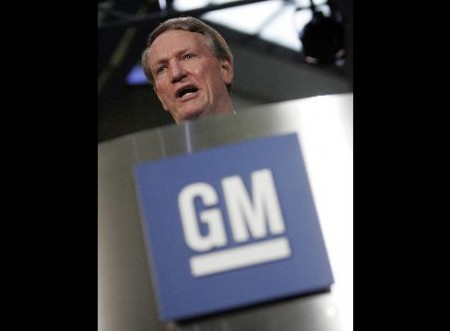
Rick Wagoner, chief executive officer of General Motors Corp., speaks at a news conference at the company’s headquarters in Detroit, Dec. 19, 2008. Photographer: Jeff Kowalsky/Bloomberg News
Dec. 23 (Bloomberg) — General Motors Corp. Chief Executive Officer Rick Wagoner said the biggest U.S. automaker got “what we asked for” with $9.4 billion in U.S. loans over the next 24 days. Investors bet that it’s not enough.
Related: Stocks in U.S. Fall on Concern Loans Won’t Save Car Industry: GM Declines
GM dropped as much as 18 percent today in New York trading to extend yesterday’s 22 percent plunge, while credit-default swaps on GM bonds rose 0.5 percentage point in a sign of increasing concern that the Bush administration’s bailout may end in a default.
The stock-price slide erased the 23 percent gain on Dec. 19, when Detroit-based GM received a federal aid package to help the automaker stay in business until March 31 while it crafts a plan to shut plants, shed brands and reduce debt.
“It’s almost impossible for a management that invested in the assets, that hired the people, that put forth the strategy, to change so dramatically in such a short period of time,” Edward Altman, a New York University finance professor who created the Z-score formula to measure bankruptcy risk, said in a Bloomberg Television interview.
There is a “high” likelihood of a GM bankruptcy, Standard & Poor’s said yesterday in reducing the rating on the company’s unsecured debt to C, or 11 grades below investment quality. Robert Schulz, an S&P analyst in New York, said creditors can expect “negligible recovery” should the automaker default.
GM has slashed output and won union concessions since saying Nov. 7 it may run out of operating cash by year’s end. The automaker said it would need as much as $18 billion in aid or face a possible bankruptcy.
Aid Timetable
President George W. Bush promised $4 billion by Dec. 29 and an additional $5.4 billion by Jan. 16, enough for GM to survive at least until President-elect Barack Obama takes office on Jan. 20. Should Congress release more funds from the Troubled Asset Relief Program, GM will receive $4 billion more by Feb. 17. Chrysler LLC is set to receive $4 billion, also by Dec. 29.
The loans are “going to get us through this rocky period,” Wagoner told Detroit radio station WJR yesterday. “The funding that we received is what we asked for.”
GM and Ford Motor Co. both declined. GM fell 58 cents, or 16 percent, to $2.94 at 12:39 p.m. in New York Stock Exchange composite trading, after touching $2.90. Share of Dearborn, Michigan-based Ford dropped 42 cents, or 16 percent, to $2.17.
Shareholders may be “wiped out” by the restructuring needed for the bailout, analyst Christopher Ceraso of Credit Suisse AG said yesterday. He cut his rating to “underperform” from “neutral” and slashed his target price in half to $1.
Credit-Default Swaps
The upfront price on GM credit-default swaps rose 0.5 percentage point to 81.5 percent, according to CMA Datavision in New York. That’s in addition to 5 percent a year, meaning it would cost $8.15 million initially and $500,000 a year to protect $10 million of GM bonds for five years.
GM’s 8.375 percent note due July 2033 fell 2.5 cents to 16 cents on the dollar, according to Trace, the bond-pricing service of the Financial Industry Regulatory Authority. The yield was 52.2 percent.
Wagoner said last week that having secured the federal loans, GM’s biggest challenges would be working with debt holders on debt-for-equity exchanges and negotiating cost-saving agreements with unions.
He told WJR yesterday that he had “done a significant amount of thinking” about a new plan to keep the U.S. funds, though “it’s fair to say a lot of that work will start up in earnest at the beginning of next year.”
United Auto Workers spokesman Roger Kerson didn’t return calls yesterday seeking comment. The Canadian and Ontario governments also pledged GM C$3 billion ($2.45 billion) in aid last week.
Sales Slump
GM is struggling with a 22 percent plunge in U.S. sales this year, worse than the 16 percent industrywide slide, and is considering paring its Pontiac lineup to one model from six and is trying to sell its Saab and Hummer franchises.
“Every aspect of the business is being examined and re- examined and re-examined,” Wagoner said in the radio interview. “If we keep doing that, we can find ways to squeak out some more costs that aren’t essential for customers and do things differently.”
“It’s not without some pain,” he said, without providing details.
That’s being optimistic, said Credit Suisse’s Ceraso, who is based in New York. The “best-case scenario” may be the “complete or near-complete elimination” of GM’s equity value, assuming that bondholders and the UAW agree to concessions under the bailout plan, he said.
Should those parties not reach an accord, “GM may still end up in bankruptcy court,” he said.
To contact the reporter on this story: Greg Bensinger in New York at [email protected]
Last Updated: December 23, 2008 13:08 EST
By Greg Bensinger
Source: Bloomberg